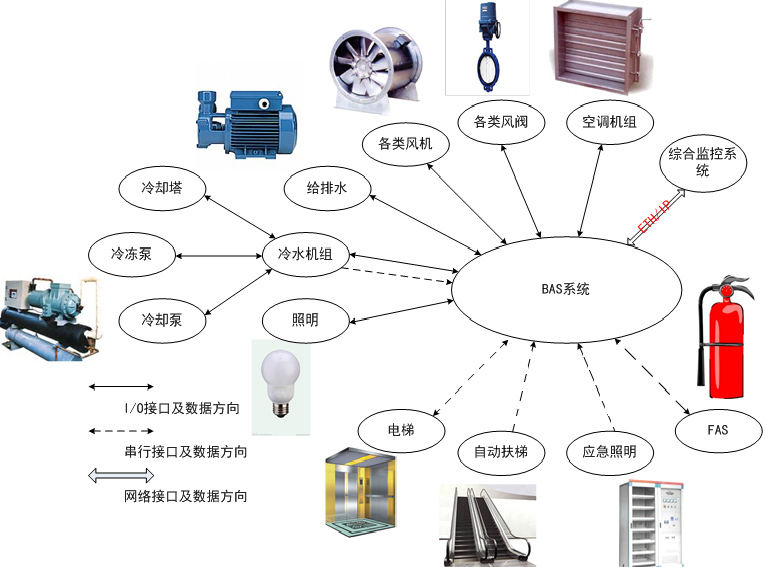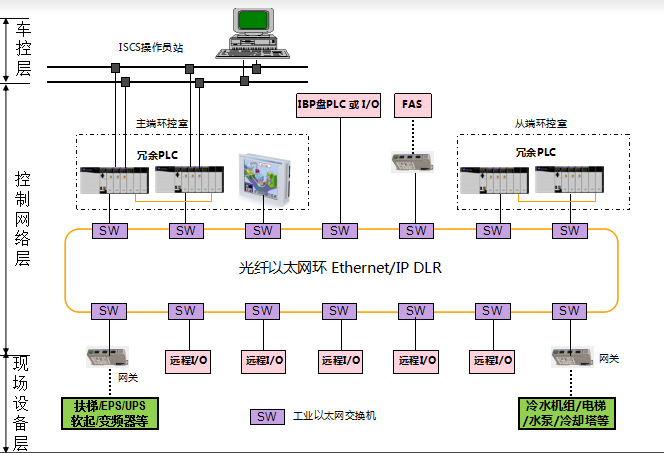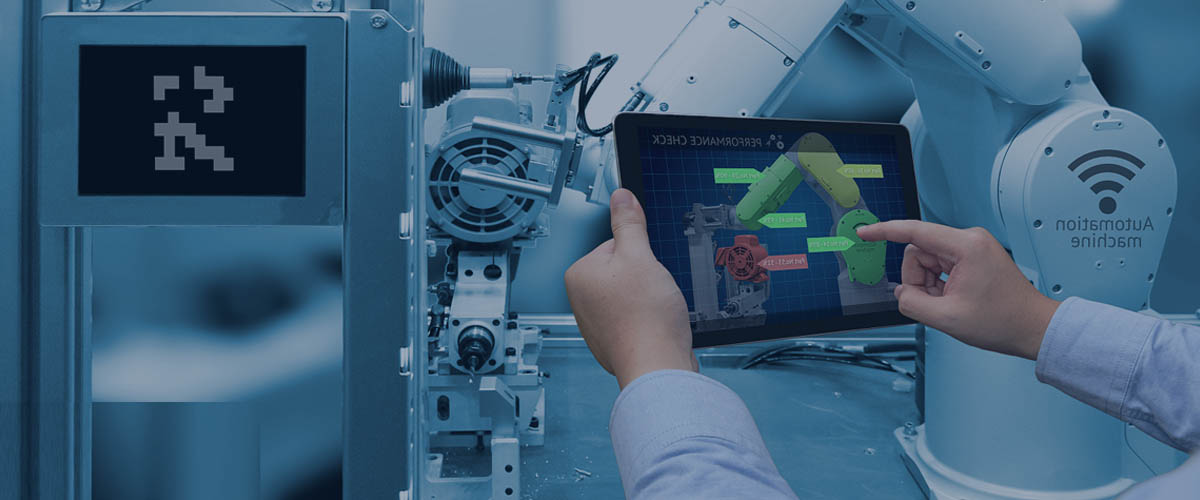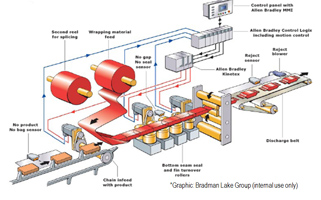Industry Capability
According to the business characteristics of various industries, we create personalized industry solutions and provide users with one-stop products and services.
Industry Capability
Related cases
Rail transit
1. BAS system
As an important subsystem in the integrated monitoring system, BAS mainly controls the tunnel ventilation system, station ventilation and air conditioning system, station chilled water system, water supply and drainage system, escalator, Elevators, lighting systems, civil air defense doors/anti-flooding doors and other electromechanical system equipment are monitored, controlled and scientifically managed according to the requirements of setting functions, system operating conditions and subway environmental standards, and can cooperate with the FAS subsystem and PSCADA under the integrated monitoring system Subsystems, etc. create a comfortable, safe and reliable ride environment for subway lines.
The low-voltage power distribution system is equipped with an intelligent power distribution system (MCC) in the environmental control electronic control room, which is responsible for the monitoring of various fans (including interlocking air valves), frequency converters, motor protectors and other monitored equipment in the environmental control ventilation and air conditioning systems. Centralized collection of operation and maintenance statistics such as running status, manual/automatic control, fault alarms, etc., and at the same time accept the control commands of the BAS system to realize the on-off control of the controlled equipment. Except for the on-board control box of the chiller and the frequency conversion control cabinet of some equipment, all other environmental control equipment are equipped with on-site manual operation boxes. The MCC system can complete the single control, group control, sequence control, and logic control of the environmental control equipment. When the integrated monitoring system has not been adjusted, single control, group control, sequence control and logic control can be completed through the MCC system.
According to the functional requirements of the BAS of the underground station, a set of redundant Rockwell Automation high-end product ControlLogix PLC is installed at both ends of the underground station, and the IBP is used as the framework of the remote I/O station to form the station BAS. The I/O and remote I/O selected by the IBP panel are both high-end Flex I/O series input and output modules of Rockwell Automation. At the same time, a BAS maintenance workstation is set up in the station control room to monitor and maintain the BAS system on a daily basis.
In order to ensure the compatibility between the MCC system of the motor control center and the BAS subsystem of the integrated monitoring system, Rockwell Automation's motor protection control module, gateway PLC ControlLogix system, PLC system CompactLogix, and 150-F series are also used in the MCC system. SMC Flex soft starter, inverter PowerFlex755, human-machine interface PanelView Plus and other products ensure the reliability, integrity and compatibility of the entire system.


2. System Features
The BAS system of the station adopts the Logix platform product of Rockwell Automation, and the network adopts ControlNet bus technology. Logix control platform is the most advanced and powerful control platform designed by Rockwell Automation. It absorbs many latest technologies and concepts and represents the development direction of future control systems. The Ethernet/IP and ControlNet protocols used in the communication are completely open protocols, which fully meet the IEC61158 international standard and are internationally recognized network standard protocols. The RG6 coaxial cable used by ControlNet has strong anti-electromagnetic interference ability, which can ensure that it is not affected by the strong electromagnetic interference environment of rail traffic. In the long distance area, or in the interval, Dashi chooses the optical fiber as the communication medium, which can completely get rid of the electromagnetic interference. The equipment can work normally in the subway electromagnetic environment and meet the relevant national standards and specifications.
The communication transfer module used for the integration of BAS system and other subsystems is mainly the ANYBUS module of the internationally renowned Swedish HMS company, which can well support the bus transmission of Rockwell Automation. Devices can be seamlessly connected.
The hardware and software of the BAS system adopts industrial-grade products, the PLC adopts redundant configuration, and the network adopts measures such as optical fiber Ethernet and redundant ControlNet bus to fully ensure the reliability of the system. All redundant PLCs use ControlLogix with Flex I/O modules (various I/O module types remain unified), and all IBPs are equipped with Flex I/O modules, which play a great role in uniformity, good maintainability, and universality. The system structure also supports flexible expansion.
The hardware and software of the system have the functions of fault diagnosis, online modification and offline editing. ControlLogix processor has strong executability and compatibility, and has very powerful diagnosis, processing and recovery functions for the system. And can be detailed to I/O and field instrument level diagnosis, can monitor the running status of each module, Logix platform is a real transparent structure.
Through Rockwell Automation's unique Produce/Consumer method, use ControlNet redundant field control bus. Since the system adopts redundant configuration in PLC host, field bus, etc., if there is a single point of failure in these parts, the system can still run normally without affecting any data acquisition and control output of the system, but the system will alarm and prompt Repair the defective part.
The mode control requirements issued by all station-level BAS systems can rely on the chain protection of the program, and have the function of conflict detection, which will not conflict with other operations. The control signal can be fed back to the equipment that sends out the control request in less than 1 second, and the control mode can be started in 1 second. For the parts that are not redundantly equipped (such as IO boards), a single-point device failure will only affect the data acquisition or control output related to the device, while other parts of the system remain in normal operation. repair.
The BAS system uses a separate intermediate relay for signal isolation and power amplification for the output control circuit, and all inputs have independent photoelectric isolation functions, which are dust-proof, anti-corrosion, moisture-proof, mildew-proof, shock-proof, anti-electromagnetic interference and electrostatic interference. , to ensure safe and reliable operation in the subway environment.
ROCKWELL in a typical station of BAS system - fully redundant dual network

3. Application in environmental control
1. System introduction
The station environmental control system, namely the ventilation and air conditioning and smoke prevention and exhaust system, mainly has two functions: one is to provide a comfortable and suitable environment for passengers and equipment in daily operations; Detoxification, heat removal, play the role of life support and auxiliary fire fighting. The system consists of tunnel ventilation system (including section tunnels and station tunnels), ventilation and air conditioning and smoke prevention and exhaust systems in station public areas (referred to as large station systems), ventilation, air conditioning and smoke prevention and exhaust systems for station management and equipment rooms (referred to as small station systems) And refrigeration (water system) system composition. Environmental control equipment mainly includes chillers, cooling water pumps, chilled water pumps, cooling towers, air-conditioning fan cabinets, TVF fans, U/O fans, jet fans, various types of supply/exhaust fans, dampers, fire dampers, etc.
The Motor Control Center (MCC) centrally manages power distribution and instrumentation equipment, incorporating various motor control units, feeder joint units, distribution transformers, lighting switchboards, interlocking relays, and metering equipment into an integrally installed machine. inside the enclosure and powered by a common enclosed bus. In the control chain of the automation system, MCC plays an important role in undertaking. It can provide power and control for various electrical equipment downwards, and can communicate with the automation system information upwards.
The subway's environmental control solution is an intelligent control system based on Rockwell Automation's advanced product DeviceNet network. The MCC switch cabinet that controls the environmental control equipment is connected to the automation system through a cable to form an intelligent network control system. This intelligent MCC system successfully avoids the disadvantages of complicated wiring, many fault points and low reliability through point-to-point hard wiring. It combines hardware, software and network organically to easily and safely realize the information with the automation system. Interactive delivery. Figure 1 shows the structure diagram of the intelligent MCC system of Changlong Station.
In each MCC cabinet, the control of the environmental control equipment is realized through the intelligent small PLC or the intelligent motor protection equipment hanging on the three DeviceNet buses.
(1) For the damper, the input state of the damper is connected to the input module of the MicroLogix 800 series small PLC, and the output module of the small PLC produces the control output to the damper.
(2) For small system motors, use E3 Plus to receive the input state quantity of the motor, and generate control output to the motor to control the start and stop of the motor. E3 Plus itself has a field bus interface, which can be directly connected to the field bus.
(3) For tunnel fans with a power greater than 75KW, the soft starter of the SMC Flex series is used to control the start and stop of the motor. The soft starter is directly connected to the DeviceNet bus through 20-COMM-D.
(4) For air-conditioning fan cabinets, return and exhaust fans, cooling and chilled water pumps, etc., PowerFlex755 series inverters are used to control motor start-stop and speed regulation. The frequency converter is directly connected to the DeviceNet bus through 20-COMM-D.
(5) An industrial computer with touch function (embedded in the control cabinet) is installed in the environmental control rooms at both ends of each station, and the system activities of the entire MCC system can be monitored through the HMI.
(6) Communication with the BAS system By configuring an industrial computer with touch function (embedded in the control cabinet) in the environmental control rooms at both ends of each station, the system activities of the entire MCC system can be monitored through the HMI.
2. System Features
(1) The environmental control system itself is equipped with a set of independent controllers, which can complete the single control, group control, sequence control, and logic control of the equipment. When the BAS has not been adjusted or the BAS is faulty, smoke prevention and exhaust can be completed through the industrial computer. Control, emergency ventilation mode control, single control, group control, sequence control, logic control and other functions, the system reliability has been improved.
(2) The environmental control system adopts DeviceNet field bus technology, which reduces the cost of control cables and investment, and connects different devices by three field buses, which reduces the risk caused by bus failures.
(3) The application of advanced intelligent control components of Rockwell Automation makes the MCC system have advanced control functions. E3 Plus highly integrates the functions of CPU, I/O modules, intermediate relays, and motor protection modules. The SMC Flex series soft starter has 7 starting modes. The soft starter can ensure that the tunnel fan can reach the rated speed from start-up within 14s, and the switching time from forward to reverse and from reverse to forward is less than 60 seconds. , to meet the special requirements of subway station fire protection. PowerFlex70/700 series inverters support the vector control mode, which not only has the functions of automatically adapting the motor, automatically adjusting the carrier frequency, automatically adjusting the voltage-frequency ratio, and automatically adjusting the acceleration and deceleration time, but also has obvious effects of energy saving and noise reduction.
(4) The environmental control system has complete equipment-level diagnostic functions, intelligent components can monitor the real-time running status of each motor, and have a pre-alarm mechanism. If the motor trips, the smart MCC can indicate the cause of the trip: phase loss, stall, overload or ground fault. The DeviceNet network can be easily connected with the ControlNet and EtherNet/IP networks seamlessly, and the fault information can be accurately and quickly sent to the BAS system, and the system has high expansibility.
(5) The maintenance of the environmental control system is very simple and efficient. Based on the DeviceNet fieldbus, Rockwell Automation's motor protectors, soft starters, and frequency converters support the Auto Device Replacement (ADR) function. Device replacement can be plug-and-play, and maintenance costs are greatly reduced.
Contact Us
Building 6, Ningxing Jiali Plaza, No. 185 Mingxin Road, Yinzhou District, Ningbo City
Tel:( 86-574 ) 87861201
Fax:( 86-574 ) 87861200

Official Account

WeChat Channel
© 2021 JETRON Powered by www.300.cn 浙ICP备12043472号-1 SEO




















